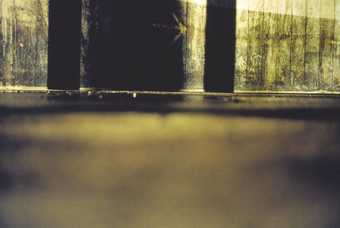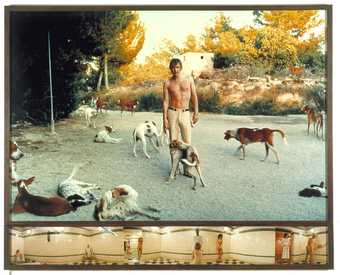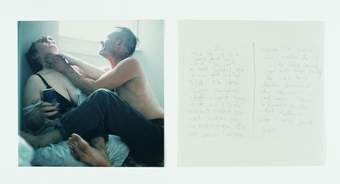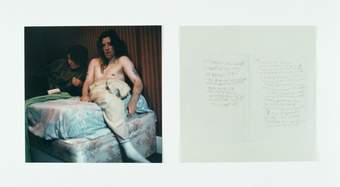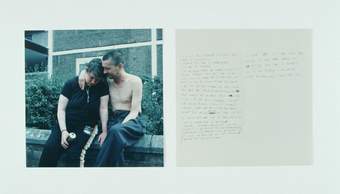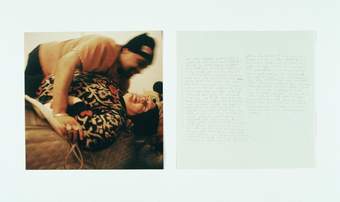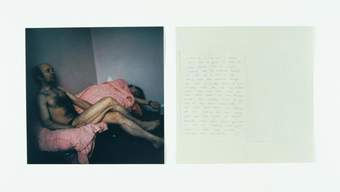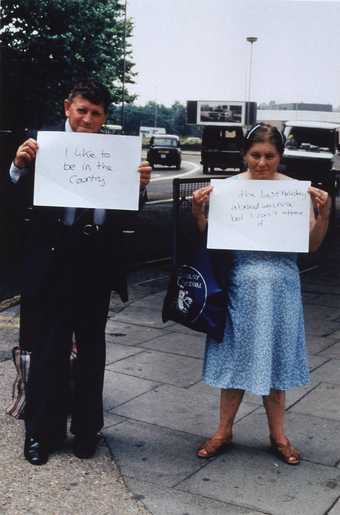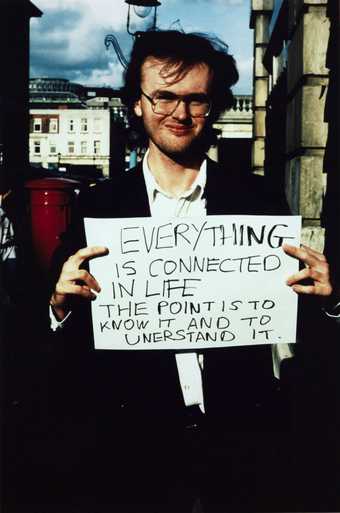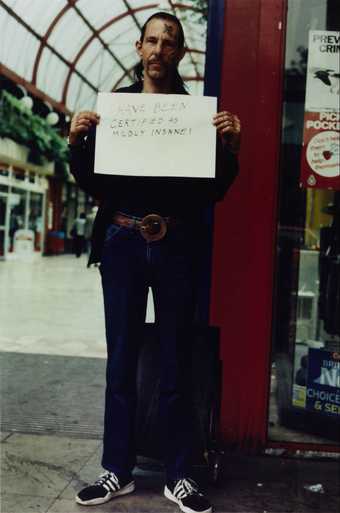
In Tate Britain
- Artist
- Gillian Wearing CBE born 1963
- Part of
- Signs that Say What You Want Them To Say and Not Signs that Say What Someone Else Wants You To Say
- Medium
- Photograph, colour, chromogenic print, on paper
- Dimensions
- Frame: 1325 × 925 × 45 mm
support: 1190 × 790 mm - Collection
- Tate
- Acquisition
- Purchased 2000
- Reference
- P78348
Summary
Gillian Wearing first attracted public acclaim when she exhibited this series of photographs at City Racing, a small artist-run gallery in London in 1993. She had been using video and photography since the early 1990s, but this was her first significant collaboration with members of the public. Standing in a busy area of South London, Wearing stopped passers-by and asked them to write down what was on their mind. With their permission, she then photographed them holding their statement. As indicated by the title of the work, Wearing has written that this collaboration ‘interrupts the logic of photo-documentary and snapshot photography by the subjects’ clear collusion and engineering of their own representation.’ (Wearing 1997, p.3.)
The complete series of Signs is comprised of over fifty colour photographs. A broad cross-section of people participated in the photographs and the series provides a fascinating social and historical document. It refers to the economic decline in Britain in the early 1990s, manifested by statements such as ‘Will Britain get through this recession?’. However most of the signs express intimate thoughts or personal convictions. This selection of five photographs shows the wide range of responses Wearing elicited from the collaborating members of the public. One of the photographs shows an elderly couple, standing on the curb of a busy street, holding a sign saying ‘I like to be in the country’, while another photograph shows a homeless man bearing the poignant statement: ‘I signed on and they would not give me nothing’. Among the group is one of Wearing’s best known images which depicts a smartly dressed young man with a mild, even complacent, expression holding a sign saying simply, ‘I’m desperate’. In a 1996 interview Wearing described how ‘People are still surprised that someone in a suit could actually admit to anything, especially in the early 1990s, just after the crash… I think he was actually shocked by what he had written, which suggests it must have been true. Then he got a bit angry, handed back the piece of paper, and stormed off.’ (Unpublished interview with Marcus Spinelli, South Bank Centre 1997.)
Like many of Wearing’s later works, such as Confess All on Video. Don’t worry you will be in disguise. Intrigued? Call Gillian. 1994 (Tate T07329), the Signs series examines the relationship between public image and private identity. Wearing often cites the influence of early British ‘fly-on-the-wall’ television documentaries such as Michael Apted’s pioneering Seven-Up (Granada Television 1964), which charted the progress of a group of children at seven year intervals, or Paul Watson’s raw investigation of family life in The Family (BBC 1974). In these television programmes intimate experiences were presented to a nationwide audience as apparently unmediated ‘real life’. However the tradition of ‘fly-on-the-wall’ documentaries, as well as confessional TV chat shows, imply an authenticity which Gillian Wearing persistently questions. In an attempt to break down social stereotypes and masks, Wearing frequently works with people marginalised by mainstream society, such as homeless people. She has said: ‘A great deal of my work is about questioning handed-down truths… I’m always trying to find ways of discovering new things about people, and so in the process discover more about myself.’ (‘Sign Language’, Dazed and Confused, no.25, 1996, pp.53, 55.)
Further reading
Gillian Wearing, Signs that say what you want them to say and not Signs that say what someone else wants you to say 1992–1993, London 1997.
Donna De Salvo, Russell Ferguson, John Slyce, Gillian Wearing, London 1999.
Sacha Craddock, Spotlight on Gillian Wearing, exhibition catalogue, South Bank Centre, London 1999.
Jemima Montagu
March 2001
Does this text contain inaccurate information or language that you feel we should improve or change? We would like to hear from you.
Display caption
The series of photographs called Signs... brought Wearing international recognition when it was first exhibited in 1993. This selection of five images shows the range of responses which Wearing elicited from passers-by, whom she selected at random, and asked to write their thoughts on a piece of paper. Wearing challenges social stereotypes and assumptions, and often works in collaboration with members of the public as a means of 'interrupting the logic of photo-documentary and snapshot photography.' She has said 'A great deal of my work is about questioning handed-down truths.'
Gallery label, September 2004
Does this text contain inaccurate information or language that you feel we should improve or change? We would like to hear from you.
Explore
- emotions, concepts and ideas(16,416)
-
- formal qualities(12,454)
-
- photographic(4,673)
- clothing and personal items(5,879)
-
- suit(301)
- placard(127)
- inscriptions(6,664)
-
- phrase(100)
You might like
-
Richard Billingham Arrow
2000 -
Gillian Wearing CBE The Garden
1997 -
Sam Taylor-Johnson OBE Soliloquy II
1998 -
Sam Taylor-Johnson OBE Soliloquy I
1998 -
Gillian Wearing CBE Theresa and Ben
1998 -
Gillian Wearing CBE Theresa and Seamus
1998 -
Gillian Wearing CBE Theresa and Chris
1998 -
Gillian Wearing CBE Theresa and George
1998 -
Gillian Wearing CBE Theresa and Mick
1998 -
Gillian Wearing CBE Theresa and Ali
1998 -
Gillian Wearing CBE Theresa and Gerry
1998 -
Gillian Wearing CBE ‘I like to be in the country’
1992–3 -
Gillian Wearing CBE ‘I signed on and they would not give me nothing’
1992–3 -
Gillian Wearing CBE ‘Everything is connected in life...’
1992–3 -
Gillian Wearing CBE ‘I have been certified as mildly insane!’
1992–3

